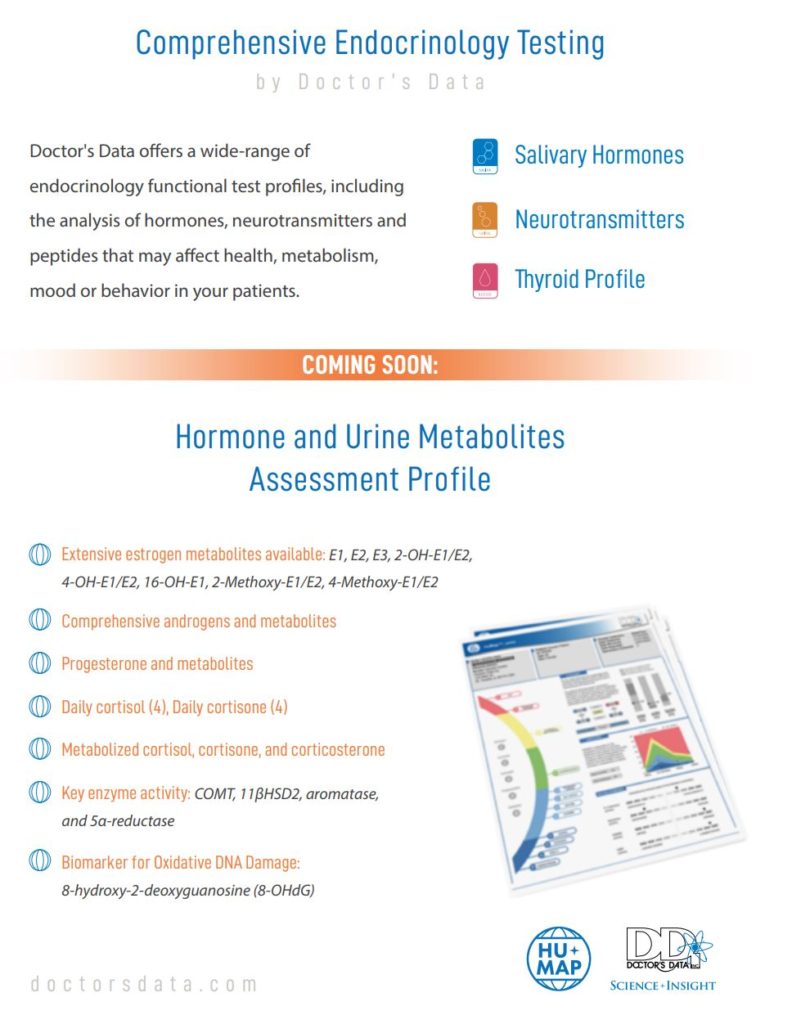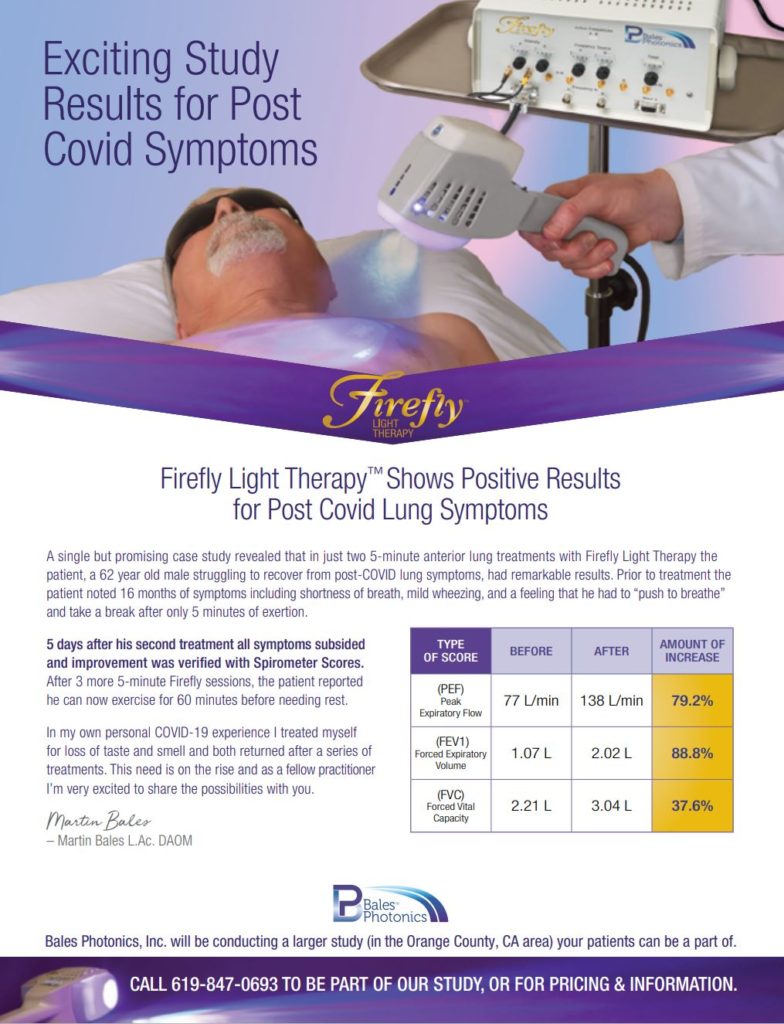By Lylen Ferris, ND
Many practitioners face the challenge of helping patients address hormone imbalance, which can include a complex spectrum of signs and symptoms. As a result, it’s important to choose appropriate testing for the challenges facing each individual patient. Different situations will call for testing hormones in different mediums.
The two mediums most used in functional hormone testing are saliva and urine. It is helpful to understand the advantages and disadvantages of each in order to understand the appropriate time to test. While both are appropriate for baseline testing, an understanding of how to monitor hormone therapy is essential. If you’re measuring the wrong medium, tissue uptake of supplemented hormone may not be accurately reflected in results, which can lead to inappropriate dosing.
Before speaking about the differences between saliva and urine hormone testing, a review of steroid hormone physiology is helpful.
Steroid hormones (i.e. estradiol, testosterone, progesterone) are fat soluble molecules made with a cholesterol backbone (hydrophobic/lipophilic) that renders them insoluble in water. Because steroid hormones are hydrophobic, they must either be bound to a carrier protein that allows them to travel in water (such as in serum) or conjugated into metabolites, which are water soluble (as in urine). It’s important to understand that while urine is water based, saliva is more favorable for measuring fat soluble hormones. When blood is filtered through the salivary glands, only the unbound/free hormones pass through and into the saliva. This concept is foundational to understanding the appropriate medium to test certain hormones.1
Salivary Hormone Testing Advantages
Saliva testing is noninvasive, a boon for needle phobic patients. Saliva measures the active, bioavailable, unbound portion of sex steroid hormones. Again, we must consider steroid hormone physiology. Endogenous hormones are secreted from the ovaries, testes, or adrenals wrapped in protein envelopes called sex hormone binding globulin (SHBG), cortisol binding globulin (CBG), etc. so that they can be transported in the serum. As a result of protein-binding, these hormones are only partially biologically active. The biologically active portion is the 1-10% that is unbound. Saliva contains no carrier proteins, only biologically active hormones.2
Sex hormones are secreted in a pulsatile manner over the course of the day (and night). Spot testing of any kind may not be sufficient for assessing overall hormone secretion, as it may catch a peak or a trough level, or something in between. Many labs will advise that patients collect multiple samples throughout the day, and then take a small aliquot from each specimen to create a pooled sample. It is from this pooled tube that hormones are tested, providing an average value for the sex hormones. This average value is a more reliable reading upon which to base therapeutic recommendations.
Lastly, saliva samples are convenient to collect, especially when multiple samples are needed or the timing of a sample is important. Saliva testing is particularly advantageous in the testing of cortisol, primarily because of the ease of collection at multiple times throughout the day. When measuring the cortisol awakening response (CAR), the first collection is taken within five minutes of waking, followed by another 30 minutes later to measure the daily cortisol spike, or “the cortisol awakening response.” Diurnal cortisol is typically collected at four points over the course of the day. Saliva testing enables the avoidance of needles and “white coat hypertension,” which can initiate a stress response and influence cortisol levels. As a result of being able to collect samples in one’s own milieu, saliva is the best method for functional testing of cortisol.3
In cycling women, the recommended time frame to test hormones in saliva is during the height of the luteal surge, days 19-23. While sex hormones fluctuate over the course of the month, the best time to assess ovarian function is approximately seven days after ovulation when progesterone levels are highest. Saliva testing makes this collection timing easier for patients.4,5
Salivary Hormone Testing Disadvantages
There are some disadvantages to salivary hormone testing. Because it is restricted to steroid hormones (such as sex hormones, cortisol, and melatonin) and due to its non-polar, lipophilic structure, it is not possible to test polar molecules such as thyroid hormones, LH, or FSH.
Unexpected hormone elevations can be seen in salivary testing commonly due to either contamination or exogenous exposure. Contamination of a saliva sample occurs when the saliva sample or sample collection tube comes into contact with a topical or sublingual hormone supplement at the time of sample collection. Hormones are prescribed in milligram (mg) dosages, denoted as 103. The sensitive testing equipment that is used to measure salivary hormones is designed to measure hormones present in much smaller concentrations. To be specific, samples are measured in picograms, or 1012. There are 1 billion picograms in 1 milligram, so even a trace amount of a milligram sample will cause picogram measurements to be significantly elevated. Patient education on how to prevent contamination is imperative and will prevent the need to retest. Exogenous exposure typically occurs in two ways: through exposure to the patient’s own or another person’s topical hormone products, or through the use of a product that contains a hidden hormone (anti-aging creams are a common source). Also called transference, this kind of exposure is often from a partner or household member who is using transdermal hormone replacement therapy, although more incidental exposures are also possible such as from a hands-on practitioner or from gym equipment.
Salivary Hormone Testing for Monitoring Hormone Therapy
Testing for baseline levels of hormones is important, but after implementing hormone therapies it is equally important to choose a method that will allow adequate assessment of the therapeutic response. Saliva can be used to monitor any route of administration of hormone therapies (oral, transdermal, transmucosal/sublingual, patch, IM, sub-Q, pellet). It is the only medium in which one can reliably monitor transdermal/sublingual therapies. These routes of administration are incredibly popular in patient management because they avoid first pass.
It has been erroneously stated that sublingual hormone therapies cannot be monitored in saliva. While there is the potential for contamination, because the testing medium comes from the same place hormones are being administered (saliva); with care, it has been shown that therapeutic levels can be successfully measured. Saliva testing laboratories recommend carefully following the dosage interval between hormone use and sample collection and cleansing the mucosa after the last dose of hormone administration, in order to increase the likelihood of collecting an unadulterated sample. An additional pearl is to recommend the patient use a new toothbrush after the mucosa has been rinsed thoroughly, to avoid the possibility of re-inoculating themselves with residual hormone on the bristles. Because sublingual hormones will not be reflected in serum or urine testing (see below), saliva is the best method to monitor therapeutic response, despite the potential for contamination.
There are several mechanisms that contribute to saliva being the best method for measuring transdermal and transmucosal hormone therapies. When transdermal hormones are applied, they are absorbed freely through the skin and are largely not bound to protein carriers like albumin or SHBG. Instead, these transdermal hormones are picked up by the red blood cells, adhering to their fatty membranes. Transdermal hormone absorption is quick and efficient, showing up in saliva in minutes to hours, indicating absorption and availability to cells in a biologically active form.6
While red blood cells do serve as carriers for transdermal hormones, the bonds are weak. When RBCs move through capillaries, the hormone easily leaves the carrier RBC and moves into cells. Because of their lipid solubility, steroid hormones diffuse freely through the cell membrane where they enter the nucleus and affect cell function and metabolism. Once hormones are catabolized within the cell by cellular organelles, they will never be seen again in their free form but can now be monitored in their metabolized form in urine.7
While testing in serum is not a focus of this article, it can be helpful to contrast serum and saliva testing to further illustrate the concept of why saliva is the best method for monitoring transdermal hormones. When we think about monitoring transdermal hormone supplementation in serum, we must consider the way that serum is handled. When blood is drawn from a patient who has applied transdermal hormone, we understand that a large portion of the hormones are attached to RBC membranes. To separate serum, the blood is allowed to clot, then is spun down and the red blood cells are discarded… along with the transdermal hormones attached to their membranes. Thus, venous blood and urine are not optimal matrixes to monitor transdermal or transmucosal therapies.
Saliva is the best testing method to ascertain tissue levels of hormones, and to monitor supplementation, especially transdermal and sublingual routes of administration.8,9 However, if information on how the body is metabolizing and excreting hormones is desired, then urinary testing is appropriate. Urinary hormone testing is the only way to see how the body is metabolizing hormones. Studying metabolites can offer a deeper dive into how hormones may affect physiology.
Urinary Hormone Testing Advantages
The advantages of urinary hormone metabolite testing include the non-invasive nature of the testing, so needle phobic patients should be comfortable.
The natural pooling of urine in the bladder before a void results in the ability for urinary testing to provide an average of hormone and metabolite secretion. This process naturally smooths out the pulsatile nature of hormone secretion, providing an average of hormone secretion in a 24-hour period.
Like saliva, urine samples are convenient to collect, especially when multiple samples are needed, or the timing of a sample is important, as in cortisol or luteal phase testing.
Hormone metabolites have physiologic action on their own; measuring them can also provide information on the activity of the enzymes that conjugate and prepare them for excretion. Measuring various hormone metabolites allows the practitioner to monitor phase 1 and phase 2 detoxification and assess the quantities of metabolites and how they may affect physiology.
Cortisol metabolites can provide a deeper dive into cortisol production and metabolism. It is estimated that free cortisol makes up only 1-5% of the total amount of cortisol present in the body.10 Testing urinary cortisol, cortisone, and metabolites, as well as salivary cortisol, can help to answer the question, “Is it the production or metabolism of cortisol that is influencing a patient’s cortisol levels?”
Regarding androgens, some find it helpful to monitor activity of the 5-alpha and 5-beta reductase pathways, as the 5-alpha pathway is more androgenic. Metabolites like dihydrotestosterone (DHT), when elevated, can be problematic for males and females alike.

Some providers find it useful to monitor the conversion of the OH-estrogens to the less carcinogenic methoxy forms of estrogen metabolites. Commonly, the 2, 4, and 16-OH estrogens are monitored, as well as their ability to covert to their methoxy forms. The 4-OH pathway is typically considered to have the most carcinogenic potential. If 4-OH estrogens are not methylated, they are prone to the formation of catechol estrogen-derived 3,4 semi-quinones – free radical-generating molecules that have been shown to lead to DNA mutogenesis.11,12
An additional benefit of urine testing is the ability to test other non-hormonal markers from the same sample, such as 8-OHdg, a marker of oxidative stress, and neurotransmitters.
Some providers use urinary hormone testing in conjunction with salivary hormone testing, as it allows one to determine if an elevation or deficit of a reported hormone is related to its secretion or metabolism.
Urinary Hormone Testing Disadvantages
As with all methods, urinary testing does come with some disadvantages. It is difficult to measure unconjugated/free sex hormone levels because of the biochemistry of these molecules. Progesterone, because of its proximity to cholesterol in the steroid cascade, is not water soluble enough to be found in urine. The other sex hormones (estradiol, testosterone, etc.) are slightly more polar than progesterone enabling detection in urine, but only in very small amounts. When bioavailable hormone molecules travel to the liver, they are conjugated to a glucoronidate or a sulphate which makes them polar, allowing them to float freely in the urine. Thus, conjugated forms of hormones are readily found in urine, but it is not an ideal medium for measuring free hormones.
Cortisol is polar enough to be tested in urine and has been shown to have a diurnal pattern. If providers are accustomed to testing cortisol in saliva, what is found in urine is about two hours delayed from its timing in saliva. Also, rather than the targeted spot nature of cortisol tested in saliva, every urinary collection provides an average of hormone secretion since the last void.
Urinary Hormone Testing for Monitoring Hormone Therapy
Since urine does not reflect tissue uptake, it is not considered the best possible medium for monitoring response to hormone supplementation. It is difficult to measure therapeutic levels of hormone supplementation in urine regardless of the route of administration a patient is using. Remember that when using urinary metabolite testing, the level of detectable unconjugated sex hormone levels is not likely to be representative of circulating or active tissue hormone levels.
Urine testing will usually overestimate the level of oral supplementation due to conjugation. Conjugates that are created when oral steroids are absorbed in the gut do not seem to have systemic effects, whereas when they pass through the liver, they may have systemic activity. For this reason, patients are asked to leave a dosage interval of at least two days between oral hormone usage and urinary testing.
Urinary testing typically underestimates topically applied hormones because the biomechanics of the way they’re moving through the body and the way that they are absorbed doesn’t form significant metabolites. Transdermal hormones may avoid first pass until there has been a great deal of tissue uptake, and so these hormones are less likely to be reflected in urine. While there may be a small rise in supplemented urinary hormone levels, it is as yet unclear to what extent urine results correlate with clinical improvement.
Urine can be used to monitor the hormone metabolites produced from the delivery methods of pellets and intramuscular injections, but again, monitoring in urine may prove less accurate in determining dosage.
Urine testing provides additional insight into a complex subject. Whether measuring baseline levels, or monitoring a patient’s utilization of hormone therapy, in every situation there are downstream metabolites that expand one’s view. Remember with urine testing you are not getting a picture of tissue levels of hormones, so it is not the best method to assess appropriate dosage. Saliva is a better option to monitor therapeutic response.
In summary, testing a patient’s hormones and metabolites can provide objective data that, in combination with signs and symptoms, adds a valuable layer of data enabling the practitioner to make informed treatment decisions. There are no good or bad mediums for hormone assessment, but it’s important to understand in which situations saliva is preferable to urine, and when urine is preferable to saliva. An understanding of the advantages and disadvantages of each will allow the practitioner to choose the medium most capable of providing the information needed for prescribing and monitoring hormones.
- http://e.hormone.tulane.edu/learning/types-of-hormones.html
- Gozansky WS, et al. Salivary cortisol determined by enzyme immunoassay is preferable to serum total cortisol for assessment of dynamic hypothalamic-pituitary-adrenal axis activity. Clin Endocrinol. 2005 Sep;63(3):336-41
- Meeran K, et al. Venipuncture causes rapid rise in plasma ACTH. Br J Clin Pract. 1993; 47: 246-7.
- Groschl M. Current status of salivary hormone analysis. Clin Chem. 2008 Nov;54(11):1759-69.
- Lewis JG. Steroid analysis in saliva: an overview. Clin Biochem Rev. 2006 Aug;27(3):139-46.
- Koefoed P, Brahm J. The permeability of the human red cell membrane to steroid sex hormones. Biochim Biophys Acta. 1994; 1195: 55-62
- Speroff L, Fritz MA. Clinical Gynecologic Endocrinology and Infertility. 7th ed. Philadelphia, PA: Lippincott Williams and Wilkins; 2005.
- Theme D, et al. Drug Test Anal. 2013 Nov-Dec;5(11-12):819-25. doi: 10.1002/dta.1536. Epub 2013 Oct 25.
- O’Leary P, et al. Salivary, but not serum or urinary levels of progesterone are elevated after topical application of progesterone cream to pre- and postmenopausal women. Clin Endocrinol. 2000; 53: 615-20
- https://www.mayocliniclabs.com/test-catalog/Clinical+and+Interpretive/65484
- Cavalieri EL, et al. Molecular origin of cancer: catechol estrogen-3,4-quinones as endogenous tumor initiators. Proc Natl Acad Sci USA. 1997;94:10937–10942.
- Sepkovic DW, Bradlow HL. Estrogen hydroxylation–the good and the bad. Ann N Y Acad Sci. 2009 Feb;1155:57-67. doi: 10.1111/j.1749-6632.2008.03675.x. PMID: 19250192.

Lylen Ferris, ND, graduated from the National University of Natural Medicine, where she trained as a general practitioner and tailored her studies to focus on women’s health. Dr. Ferris is currently the senior staff physician for Doctor’s Data Inc., where she leads a team of physicians focusing on educating practitioners worldwide on hormone and neurotransmitter testing and optimization. She also maintains a clinical practice in Portland, Oregon. She is an internationally recognized speaker, teaching medical professionals around the globe at numerous functional medicine conferences, online webinars, and seminars. Dr. Ferris offers a deep knowledge and enthusiasm for teaching hormone and neurotransmitter biochemistry, including research, testing, and optimization. www.drlylenferris.com










